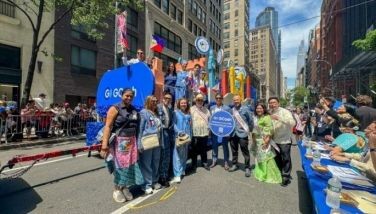Microfinancing: Changing the lives of rural folk through easy access to credit
April 2, 2002 | 12:00am
Leonides Ramos’ house is a virtual workshop.
In one corner sits a sewing machine, a small table near the front doors displays a small selection of slippers, bundles of vinyl are draped on the sofa and fabrics fill the hand-made wooden cabinets in the back. On the other side of the big reception-cum-working area a couple of men are busy sandpapering a newly finished display cabinet while another still unvarnished dining table stands nearby.
As the whole scene suggests, a variety of livelihood activities are going on in the modest wooden house with a concrete floor. Leonides makes shoes and slippers, upholstery for furniture and car seats, and sews dresses. Husband Danilo is into carpentry and woodworking.
Now employing six workers, the Ramos started with just shoe and slipper-making, skills Leonides learned when she lived in neighboring Cebu, which had its own version of Marikina. Both Bol-anons, the Ramos decided to come home and Leonides set up her own cottage shoe making venture. An illness compelled her to suspend her work and when she got better she needed the money to restart her livelihood.
The formal banking system was not an option to be considered. "Mahadlok ko moadto sa banko (I was afraid to go to the bank)," she said. She was told they would require a collateral which she did not have, and the interest rates banks charged were high.
Then she heard of the community banking the Feed the Children-Philippine (FTCP) had started in their municipality of Tubigon. FTCP is a non-government organization committed to the goal of improving the lives of disadvantaged children in the Philippines not only through programs directly benefiting kids, but through initiatives designed to improve the capability of parents to bring up happy, healthy children, It is part of FTC International, a global network of country programs. FTCI-Asia also oversees FTC Thailand’s among the hill tribe children and their families in Chiangmai. A program to promote child-friendly communes in Vietnam is in the pipeline.
Leonides recruited five of her neighbors so they could form a group. Under the scheme, whose participants are predominantly women, members are divided into groups of five with each member contributing P300 as pre-credit savings. They have to attend a series of orientation meetings.
After complying with these requirements, they can apply for a loan. for the first loan, members can borrow as much as P3,000. The maximum loan available is raised to P5,000, the second time, then P7,000 the third time. Those who are able to establish a good credit record will eventually be able to borrow as much as P25,000. The actual amount of the loan released will also depend on how much is actually needed by the borrower’s business and his/her capacity to pay. A two-percent service fee is deducted from the loan before it is released. The interest rate is three percent per month.
Instead of using her initial loan from the community bank (CB) last year to restart her earlier businesses, Leonides used it instead to get her husband’s furniture-making enterprise off the ground. "He has always been a furniture maker," she explains and has done some items on order. With the money, he formally established himself as a carpenter/woodworker.
As Danilo’s business grew – the furniture he makes is available on installment – Leonides finally resumed her other livelihood activities – the dressmaking and shoe/slipper making and added the upholstery making.
She has since repaid her P3,000 initial loan and is now amortizing her second, P5,000.
Other members of community banks in Bohol, including those outside the municipality of Tubigon, have also used their loans to start or expand existing businesses. Many buy and sell fish and, like Leonides, would never have set foot inside a formal bank to borrow money to capitalize their small businesses.
FTC data show that the community banking scheme has served a total of 272 clients since the start of the project in 1999. however, only 205 remain active until now. this means they have existing loans and/or savings with the community banks.
FTC data show that majority (74 percent) of the community banks’ clients are in trading/merchandising. Some 21 percent are engaged in manufacturing/processing while five percent are in services.
In one corner sits a sewing machine, a small table near the front doors displays a small selection of slippers, bundles of vinyl are draped on the sofa and fabrics fill the hand-made wooden cabinets in the back. On the other side of the big reception-cum-working area a couple of men are busy sandpapering a newly finished display cabinet while another still unvarnished dining table stands nearby.
As the whole scene suggests, a variety of livelihood activities are going on in the modest wooden house with a concrete floor. Leonides makes shoes and slippers, upholstery for furniture and car seats, and sews dresses. Husband Danilo is into carpentry and woodworking.
Now employing six workers, the Ramos started with just shoe and slipper-making, skills Leonides learned when she lived in neighboring Cebu, which had its own version of Marikina. Both Bol-anons, the Ramos decided to come home and Leonides set up her own cottage shoe making venture. An illness compelled her to suspend her work and when she got better she needed the money to restart her livelihood.
The formal banking system was not an option to be considered. "Mahadlok ko moadto sa banko (I was afraid to go to the bank)," she said. She was told they would require a collateral which she did not have, and the interest rates banks charged were high.
Then she heard of the community banking the Feed the Children-Philippine (FTCP) had started in their municipality of Tubigon. FTCP is a non-government organization committed to the goal of improving the lives of disadvantaged children in the Philippines not only through programs directly benefiting kids, but through initiatives designed to improve the capability of parents to bring up happy, healthy children, It is part of FTC International, a global network of country programs. FTCI-Asia also oversees FTC Thailand’s among the hill tribe children and their families in Chiangmai. A program to promote child-friendly communes in Vietnam is in the pipeline.
Leonides recruited five of her neighbors so they could form a group. Under the scheme, whose participants are predominantly women, members are divided into groups of five with each member contributing P300 as pre-credit savings. They have to attend a series of orientation meetings.
After complying with these requirements, they can apply for a loan. for the first loan, members can borrow as much as P3,000. The maximum loan available is raised to P5,000, the second time, then P7,000 the third time. Those who are able to establish a good credit record will eventually be able to borrow as much as P25,000. The actual amount of the loan released will also depend on how much is actually needed by the borrower’s business and his/her capacity to pay. A two-percent service fee is deducted from the loan before it is released. The interest rate is three percent per month.
Instead of using her initial loan from the community bank (CB) last year to restart her earlier businesses, Leonides used it instead to get her husband’s furniture-making enterprise off the ground. "He has always been a furniture maker," she explains and has done some items on order. With the money, he formally established himself as a carpenter/woodworker.
As Danilo’s business grew – the furniture he makes is available on installment – Leonides finally resumed her other livelihood activities – the dressmaking and shoe/slipper making and added the upholstery making.
She has since repaid her P3,000 initial loan and is now amortizing her second, P5,000.
Other members of community banks in Bohol, including those outside the municipality of Tubigon, have also used their loans to start or expand existing businesses. Many buy and sell fish and, like Leonides, would never have set foot inside a formal bank to borrow money to capitalize their small businesses.
FTC data show that the community banking scheme has served a total of 272 clients since the start of the project in 1999. however, only 205 remain active until now. this means they have existing loans and/or savings with the community banks.
FTC data show that majority (74 percent) of the community banks’ clients are in trading/merchandising. Some 21 percent are engaged in manufacturing/processing while five percent are in services.
BrandSpace Articles
<
>
- Latest
Latest
Latest
September 11, 2024 - 2:00pm
September 11, 2024 - 2:00pm
June 28, 2024 - 2:55pm
June 28, 2024 - 2:55pm
Recommended




























